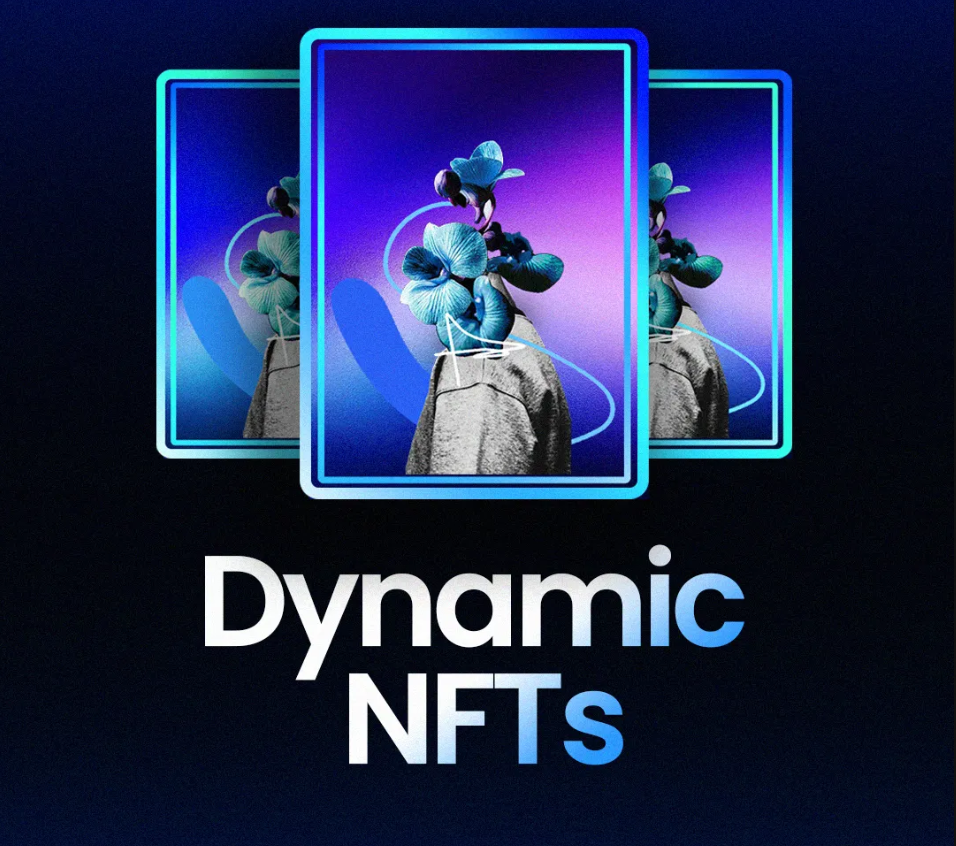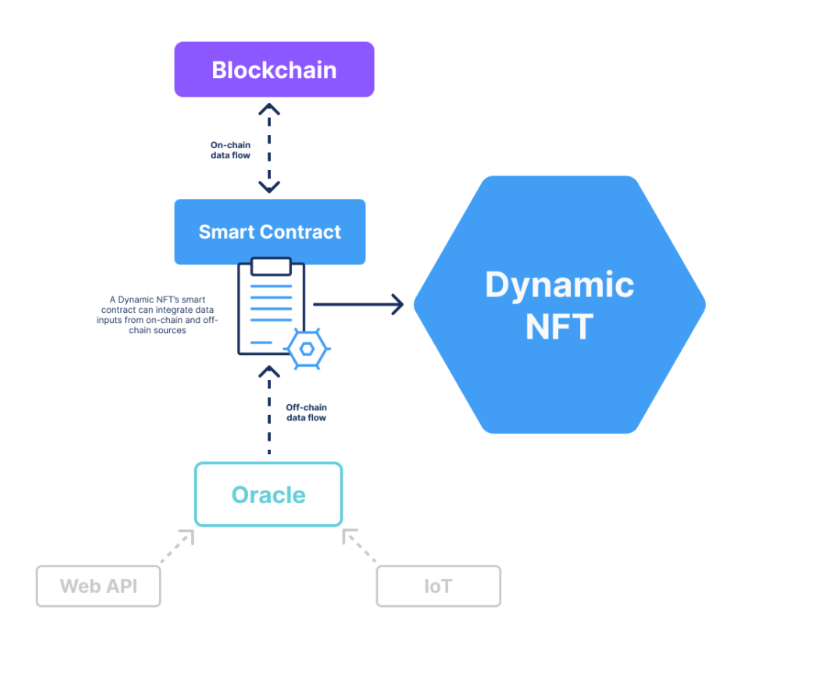What is Dynamic NFT? Dynamic NFT is a Non-fungible token (NFT) that can change its inherent properties based on external conditions. Dynamic NFT is expanding the design space that NFT can address with many different applications especially in the real world. So what’s special about Dynamic NFT? Let’s find out with Weakhand in this article.d
To better understand Dynamic NFT, people can refer to some of the articles below:
- What is NFT? All About NFTs
What is Dynamic NFT?
Dynamic NFT is a Non-fungible token that can change its original properties based on external conditions. These changes will be recorded in the NFT Metadata. A simple example of a house encoded as a Dynamic NFT, it will change Metadata based on situations such as sales history, ownership transfer, house price increase according to the data source in the world. real world…

What is Dynamic NFT
Dynamic NFT is opening up many new applications not only in the digital space but also in the real world. This helps take NFT to the next level by expanding its design space, introducing new levels of interactivity and functionalities to digital assets.
How Does Dynamic NFT Work?
Dynamic NFT works using Smart Contract – which is a self-executing program encoded in the NFT. These Smart Contracts automate specific functions allowing external events and actions of the NFT owner to trigger changes in the NFT’s information.
In addition, Dynamic NFT also uses Oracle for data updating purposes. Oracle will send external data into the Smart Contract, then the smart contract will make modifications in the Metadata of the NFT. NFT properties and characteristics will be updated soon.

Dynamic NFT working mechanism
For example: If a user wants to create a Dynamic NFT that represents special membership cards in a club or guild. Users can use the ERC 1155 standard to mint these Dynamic NFTs including Smart Contracts in the NFT Metadata.
This Smart Contract is programmed to allow NFT owners after a certain period of time (such as 1 year) to receive rewards for holding NFTs.
The external data in this case is a 1 year countdown time that will be integrated into Dynamic NFT via Oracle and the reward can be a pre-programmed NFT.
With regular NFTs, this process would have to be done manually with rewards representing members’ achievements each year. With Dynamic NFT, this is done completely automatically, potentially increasing the flexibility and scalability of NFT-related projects.
What Are the Benefits of Dynamic NFT?
Dynamic NFTs provide a lot of benefits to developers as well as users who use NFTs. Some main benefits include:
- Interactive abillity: Dynamic NFTs offer a high level of interactivity. Their flexibility and ability to change make them more attractive and interesting for users while also opening up new creative possibilities for developers.
- Programming capabilities: Dynamic NFTs are programmable, which means creators can define the rules for how the NFT behaves, providing a high level of control and automation. At the same time, it opens up many new use cases in many different fields. For example: Developers can design a Dynamic NFT representing characters in the game. Every time a player achieves an achievement or title, new attributes will be automatically updated into the NFT. of the player.
- Flexibility: Dynamic NFTs can be used in many types of services as well as different fields such as in games, social networks and others. Their versatility opens up new possibilities for developers and creators to innovate and create immersive experiences for users.
- New revenue sources: Dynamic NFTs provide a new revenue stream for artists through royalty or service fees as users continuously interact with their NFTs.
The Difference Between Static NFT And Dynamic NFT
|
|
Static NFT |
Dynamic NFTs |
|---|---|---|
|
Attributes are subject to change |
Once minted on the blockchain, their properties are fixed and cannot be changed |
May change or develop over time |
|
Programming capabilities |
Programmable features cannot be included |
It is possible to program various features and interact with data in real time |
|
Level of interaction |
Limited interoperability |
Provides high levels of engagement |
|
Revenue source |
Revenue sources are limited to copyright fees,… |
Provide many new revenue sources in users using and interacting with the platform such as: service fees, copyright fees,… |
Static NFT is still the most popular type of NFT, used by the majority of NFT collections, GameFi projects at the moment. In addition, they are also used as real-world cryptographic assets such as real estate deeds, patents, etc.
However, this model faces many limitations because the Metadata attached to NFTs is fixed after they are minted on the blockchain. Use cases such as tokenizing real-world assets, building video games, or creating blockchain-based fantasy sports leagues often require data to be regularly updated and changed. Dynamic NFTs provide a better approach that retains the characteristics of NFTs while still being able to update aspects of their data.
In addition, programmability and a high level of interactivity also help Dynamic NFTs create greater flexibility and open up new creative possibilities for developers as well as many new experiences for users. use.
Dynamic NFT Use Cases
Although Dynamic NFTs are relatively new, they show a lot of promise. Here are a few typical use cases for Dynamic NFTs:
On-string identifier
Dynamic NFTs can be used to identify users on-chain. Dynamic NFTs can represent digital identity cards or passports, with the flexibility of Dynamic NFTs allowing data to be automatically updated without the need to replace digital identity documents. This may include details of residence, marital status and some contact information.
Use in GameFi
Dynamic NFTs are widely used in gaming platforms such as game characters. The initial character in the game will have certain attributes and characteristics. If this character evolves and upgrades, the Metadata will be updated with changes in that character’s attributes. In addition, in-game equipment such as armor and weapons can also be applied by Dynamic NFT.
Another application is in virtual sports tournaments such as if the owner loses then their NFT will be automatically transferred to the winner. In general, the applications of Dynamic NFT in the GameFi field are very diverse and depend on the creativity of the developer.
Virtual real estate
Tokenizing real-world assets can be complicated, especially those whose value changes over time. A typical case is housing and real estate. House prices tend to fluctuate depending on supply and demand, interest rates and a number of other factors.
Using Dynamic NFT and updated price data via Oracle, real estate businesses can tokenize residential and land assets with ease. And the fact that data is stored on Blockchain helps users track the value of real estate at any time.
Art
Another special application of Dynamic NFT is its use in works of art. This will create dynamic works of art that can change characteristics easily through different conditions and circumstances.
For example: A Dynamic NFT is a piece of art that can change color or state depending on location, temperature, moon position, or time of year.
Another example is being able to associate a work of art with its creator or owner. For example, on an NFT owner’s birthday anniversary, specific colors or features are displayed on the NFT as a message or a gift to the NFT owner.
summary
Nowadays, NFTs have become a part of the technology world especially in the web3 community. Dynamic NFT is a breath of fresh air that has received a lot of attention from the community because of its ability to change its inherent properties based on external data. However, Dynamic NFT is still a new concept and needs to be revised and made more widely available in the web3 community. Above is all the information I want to provide about Dynamic NFT, hope everyone has received interesting knowledge.


